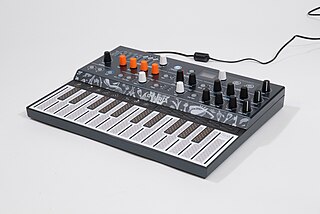Products
The company's product line includes software synthesizers, software bundles, hardware synthesizers, MIDI keyboards and sequencers, mobile apps, and other audio equipment and controllers.
Subtractive synthesis
- ARP2600 V3, a recreation of the ARP 2600 [3]
- CS-80 V4, a recreation of the Yamaha CS-80 [4]
- Mini V3, a recreation of the Moog Minimoog [5] [6]
- SEM V2, a recreation of the Oberheim SEM [7]
- Matrix-12 V2, a recreation of the Oberheim Matrix 12 [8]
- Prophet V, a recreation of the Sequential Circuits Prophet-5 [9] [10]
Keyboard emulations
- VOX Continental V2, a recreation of the Vox Continental organ [11]
- Farfisa V, a recreation of a Farfisa Organ
- Wurli V2, a recreation of the Wurlitzer electronic piano [12]
- Solina V2, a recreation of the ARP String Ensemble
- Stage-73 V2, a recreation of the range of Rhodes electronic pianos
- Clavinet V, a recreation of the Hohner Clavinet
- B-3 V2, a recreation of the Hammond B3 tonewheel organ
- Piano V3, recreates the sound of a piano via physical modelling
Samplers
- Emulator II V, a recreation of the E-mu Emulator
- Synclavier V, a recreation of the New England Digital Synclavier
- CMI V, a recreation of the Fairlight CMI
- Mellotron V, a recreation of the Mellotron
Miscellaneous plug-ins
- Analog Lab V
- Pigments, a software synthesizer with wavetable, virtual analog, sample and harmonic engines
- Vocoder V, a vocoder emulation
- Augmented Strings
- Augmented Voices
- Augmented Grand Piano
- Augmented Brass
- Augmented Mallets Play
Software effects
Filters
- Mini-Filter, a filter emulation of Moog's ladder filter with sequencing and modulation sources added
- M12-Filter, a filter emulation of Oberheim Matrix-12 filter, based on the CEM 3372 with sequencing and modulation sources added
- SEM-Filter, a filter emulation of the Oberheim SEM filter with sequencing and modulation sources added
- EQ SITRAL-295, an emulation of the Siemens Sitral equalisers
Dynamics
- Comp VCA-65, a VCA-style compressor emulating the DBX 165A
- Comp FET-76, an emulation of the Universal Audio 1176LN Peak Limiter [13]
- Comp TUBE-STA, an emulation of the Gates STA-Level vacuum tube compressor
- Bus force, a bus effects unit made by Arturia combining an equaliser a compressor and a distortion unit
Time-based effects
- Chorus JUN-6, an emulation of the chorus effect of the Roland Juno-60
- Chorus DIMENSION-D, an emulation of Roland Dimension-D chorus unit
- Phaser BI-TRON, a recreation of the Mu-tron Bi-Phase
- Flanger BL-20, a recreation of the Bel BF-20 Flanger
Reverbs and delays
- Delay TAPE-201, a tape-style delay emulating the RE-201
- Delay MEMORY-BRIGADE, a bucket brigade style delay based on Electro-Harmonix's Deluxe Memory Man
- Delay ETERNITY, a digital delay designed by Arturia
- Rev PLATE-140, a plate-style reverb, emulating the EMT 140
- Rev INTENSITY, a digital reverb designed by Arturia
- Rev SPRING-636, a spring-style reverb emulating Grampian's reverberation unit type 636
- Rev LX-24, a digital reverb emulating Lexicon's 224 digital reverb
- Efx Fragments, a granular effect designed by Arturia
Preamplifiers
- Pre 1973, a recreation of the AMS Neve preamp with a pair of parametric equalizers
- Pre TridA, a recreation of the preamps and the equalizers found in the Trident A Range mixing consoles
- Pre V76, a recreation of Telefunken's equalizers and preamplifiers
- Tape MELLO-FI, a tape style preamp/saturation module emulating characteristics of Mellotron V
Audio interfaces

- MiniFuse 1/2/4
- AudioFuse /AudioFuse 8PRE /AudioFuse Studio [14]
MIDI controllers

Hardware synths


While Arturia is mostly known for their software synths, Arturia is also making hardware synthesizers, including their analog Brute series and digital Freak series.
- Origin (2009) [18]
- MiniBrute (2012) [19]
- MicroBrute (2014) [20]
- MatrixBrute (2017) [21]
- DrumBrute (2017) [22]
- MiniBrute 2/2S (2018) [23]
- DrumBrute Impact (2018) [24]
- MicroFreak (2019) [25]
- PolyBrute (2021) [26]

- MiniFreak (2022) [27]
















